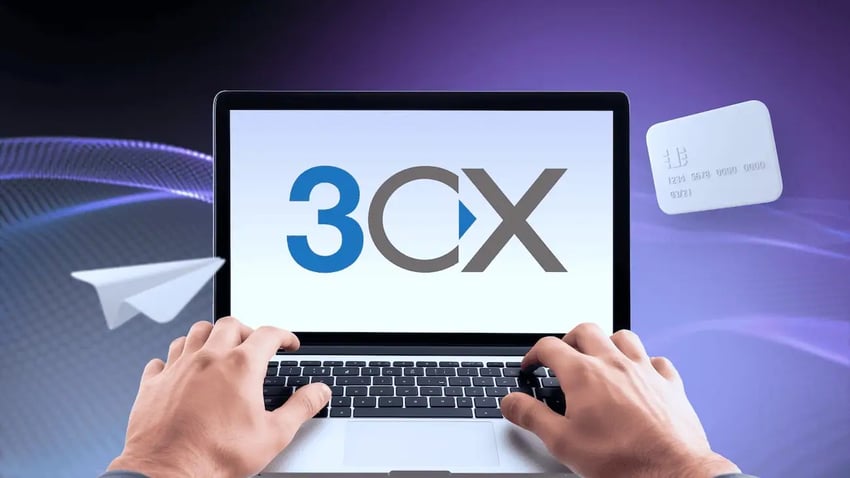For anyone running a growing team, Zoom Phone is a go-to, low-cost VoIP phone system thanks to its simplicity and ease of use. In fact, it has reached 7 million paid user seats, according to a 2024 Zoom report. However, simplicity isn’t the be-all and end-all for businesses. Some teams encounter limitations with SMS, customization, or CRM integrations. That’s where this list of Zoom Phone alternatives comes in.
As business communication needs become more complex, many small businesses and IT leaders start looking for VoIP phone systems with more advanced capabilities. This guide compares the top Zoom Phone competitors and explains why you need to give them a try.
Best Zoom Phone Alternatives At a Glance
| Provider | Starting price | Best for | Standout feature |
|---|---|---|---|
| Nextiva | $15/user/mo | Growing businesses (Unified Communications) | Unified customer experience management |
| RingCentral | $20/user/mo | Enterprise and hybrid offices | Deep integrations and hardware |
| Dialpad | $15/user/mo | AI and sales coaching | Real-time AI transcription |
| OpenPhone | $15/user/mo | Startups and solopreneurs | Shared SMS inbox |
| JustCall | $29/user/mo (Minimum 2 licenses) | International sales teams | Power dialer and global numbers |
| 8×8 | Quote-based | Unified Communications (mid-market) | Integrated UCaaS/CCaaS |
| Vonage | $13.99/user/mo | Customization and APIs | High-flexibility API platform |
| Google Voice | $10/user/mo | Google Workspace users | Simple, familiar interface |
What Makes Zoom Phone Appealing?
Zoom Phone’s biggest advantage is convenience. For companies already using Zoom Meetings or Webinars, it’s easy to add voice calling to the mix. The UI is clean and user-friendly, and billing is streamlined, which is good for smaller teams or startups looking to upgrade their phone system.
All in all, Zoom Phone is a fast on-ramp to VoIP for teams that value speed and simplicity, especially those already deep in the Zoom ecosystem. However, that same simplicity can become a bottleneck as your business grows.
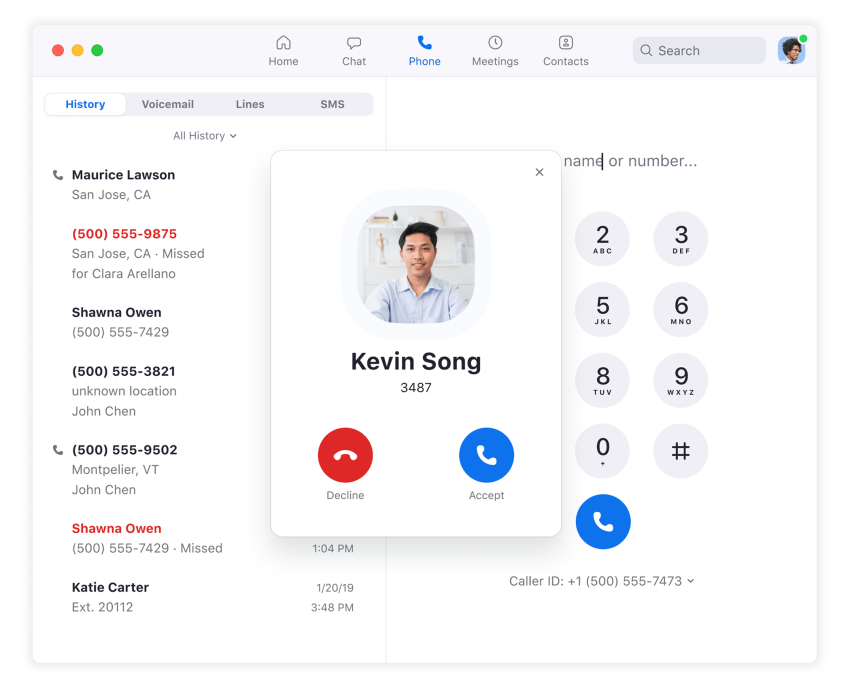
Why Businesses Look for Alternatives to Zoom Phone
At first glance, Zoom Phone is a fast, accessible service for basic telephony capabilities. But as your business communication needs mature — especially across departments like sales, support, and operations — Zoom Phone’s limitations can start to feel more like roadblocks.
In conversations across support forums, Reddit threads, and customer reviews, recurring frustrations surface around scalability, missing features, and the cost of add-ons.
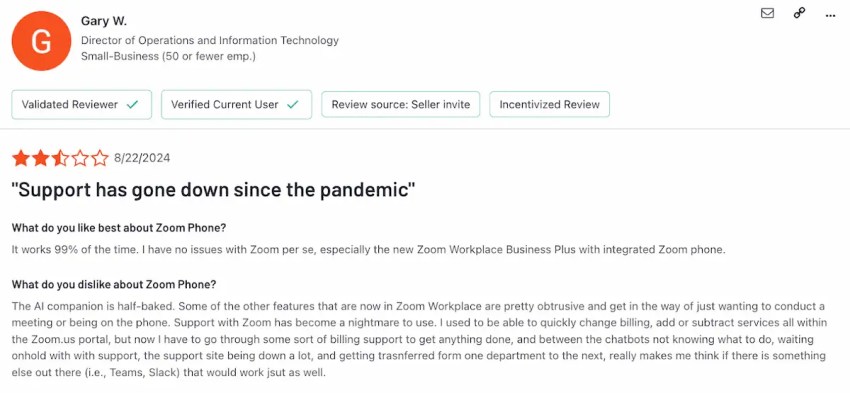
These are the most common reasons companies start considering Zoom Phone alternatives:
- Lacks advanced SMS & team collaboration: While Zoom Phone supports basic SMS, it lacks advanced features like team-based SMS messaging, auto-replies, call forwarding, or SMS on shared lines and collaboration tools.
- The high cost of add-on overload: Zoom Phone appears affordable upfront, but many essential features, such as call analytics (ZOOM Sessions) and call queue dashboards, are locked behind higher-tier plans or require additional purchases.
- Limited CRM & third-party integrations: While Zoom boasts integrations with Salesforce and HubSpot, its overall connectivity to other platforms is limited.
- Clunky interface & hard-to-access support: Some users report that Zoom Phone’s settings are hard to navigate, and live support can be difficult to access when issues arise.
- Scalability problems for growing teams: Zoom Phone struggles with advanced call routing and shared number limitations, creating challenges for growing teams or busy call centers.
If your business needs more efficient and reliable communication across teams or with customers, Zoom Phone may start to feel limited as your needs evolve.
What Makes a Zoom Phone Alternative Worth Considering?
When you move away from Zoom, you need a cloud-based unified communication platform for all your team members and customer interactions. The best alternatives don’t just replace Zoom; they streamline workflows and offer a unique, integrated solution. Here’s what we looked for when selecting these alternatives and what you should consider too:
- Unified Communications as a Service (UCaaS): A central platform for voice and video conferencing, screen sharing, team chat, and customer SMS.
- Strong CRM and software integration: Automatic synchronization of call logs, SMS messages, and notes with the customer record in your CRM.
- Advanced call management and scalability: Features such as advanced call routing (IVR/auto-attendant), call groups, and call queues for busy teams.
- Powerful team SMS/MMS: Shared team mailboxes where multiple people can manage a single number, send automatic replies, and use MMS.
- High reliability and reliable support: 99.999% uptime and 24/7 support and helpdesk assistance.
- Transparent all-in-one pricing: Essential features such as call recording, analytics, and SMS included in the package and not available as expensive add-ons.
8 Best Zoom Phone Competitors
Here’s an in-depth review of the 8 most reliable Zoom Phone competitors for small businesses, sales teams, and contact centers in 2026.
1. Nextiva
Best for: Growing companies that need their phone, customer, and internal team communication on a unified platform.
Nextiva is the complete communication platform you’ve come to expect from Zoom. While Zoom Phone is an extension of a video tool, Nextiva was built from the ground up as a unified communications platform to solve the exact scalability, support, and feature-gap problems that businesses face when they outgrow a simple VoIP service.
It provides a clear, scalable path from a best-in-class phone system to a robust customer engagement hub and all the way to a full, AI-powered omnichannel contact center.
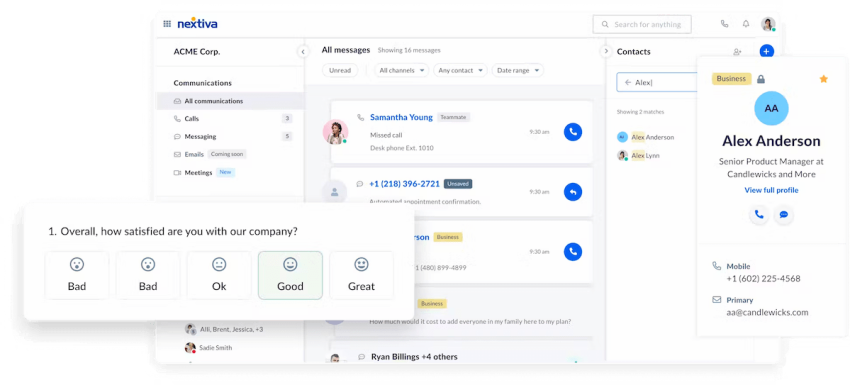
How it solves Zoom’s core problems:
- Powerful SMS and team collaboration: Unlike Zoom’s cumbersome one-to-one SMS, Nextiva offers team-based messaging. This allows a customer-facing team (e.g., sales, support) to use a single business number to send, receive, and collaborate on SMS and web chats. Nextiva is designed for teams, not just individual users.
- No bloated add-ons or hidden costs: Nextiva’s pricing is transparent. You won’t be lured in with a low price only to be charged extra for essential features. Key features like 24/7 support, advanced IVR (virtual voice recognition) systems, and unlimited calls are included in the base plan, not hidden behind a separate enterprise plan.
- Powerful AI and analytics: Zoom’s analytics come at a premium. Nextiva integrates powerful, actionable AI analytics. This isn’t just a gimmick; it provides automated call transcripts, AI-powered call summaries, and real-time dashboards for sentiment and performance analysis. This gives managers a complete overview of their team without having to purchase an additional third-party tool.

Key advantages (why businesses choose Nextiva):
- Unified conversation history: A customer’s calls, texts, and web chats are all consolidated into a single, clear history. This gives every agent a complete overview of the customer journey, eliminating context switching. It also includes screen sharing and often integrated whiteboarding capabilities for real-time team collaboration.
- Top-tier reliability and support: Nextiva offers a high uptime. And most importantly, a US-based support agent is available 24/7.
- A platform that grows with you: Whether you’re a small business with 10 employees needing a reliable phone system or a team of 100 requiring a full-fledged contact center, you use the same platform. New features can be easily activated as needed, eliminating the need to switch to a new provider. With Nextiva, you can also integrate with Microsoft 365 for contact sync and scheduling.
Considerations: As a full-fledged business communication suite, it has more features than a simple solopreneur might need.
Pricing: Get Nextiva’s pricing insights and breakdown below👇
Start calling for just $15/mo.
See why over 100,000 businesses switched to Nextiva. Now you can get it all for $15/month per user.
2. RingCentral
Best for: Enterprises and hybrid offices that require hardware support.
RingCentral is a good UCaaS offshoot of Zoom Phone that is reliable and, thanks to its extensive range of functions, can also handle complex, large-scale implementations.
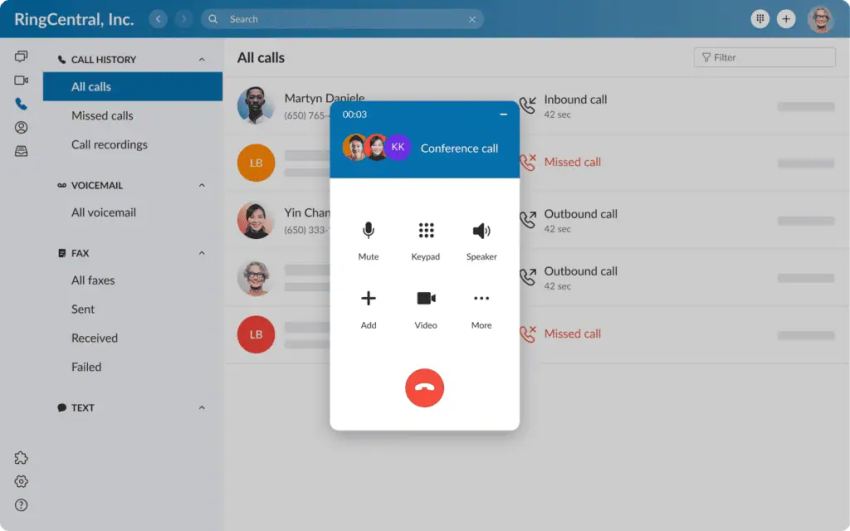
How it solves Zoom’s problems:
While Zoom Phone feels like a software extension, RingCentral is a professional phone system.
- Hardware support: Offers comprehensive support for a wide range of desk phones (Cisco, Poly, Avaya), which is crucial for hybrid offices with physical hardware.
- Detailed control: The analytics and management features are more granular than Zoom’s, allowing IT departments to manage complex call histories and user permissions.
- Integrations: Offers a large app library, with plenty of pre-configured integrations.
Key features:
- Unified platform: A single app for messaging, video, and phone calls.
- Global reach: Strong international phone numbers and rates for international calls.
- Advanced analytics: Real-time dashboards for call queues and agent performance.
Considerations: Some users find RingCentral’s interface overwhelming, and the sheer number of features can be too complex for a small team. It can also be one of the more expensive options.
Pricing: Get RingCentral’s pricing insights and breakdown below👇
3. Dialpad
Best for: AI-driven sales and support teams.
Dialpad’s communication platform is based on voice intelligence (Vi). If your main goal is to analyze customer conversations, coach agents in real time, and automate call follow-up, Dialpad is a decent solution.

How it solves Zoom’s problems:
These Dialpad features give it an advantage over Zoom Phone:
- Real-time coaching: Offers real-time transcription, sentiment analysis, and keyword tracking during a live call, so managers can identify if a call is going poorly and receive real-time help cards with answers for the agent.
- Automated workflows: Automatically generate AI-powered call summaries and action items that can be directly synced with your CRM, solving Zoom Phone’s integration problem.
Key features:
- Real-time voice intelligence (Vi): Live transcription, sentiment analysis, and keyword recognition.
- AI coaching: Automatic on-screen assistance for agents during calls.
- CRM integrations: Deep integration with Salesforce and Google Workspace for sales teams.
- Mobile device compatibility: Works on Android and iOS apps for on-the-go access.
Considerations: Dialpad’s strength is its AI; if you don’t need that, you might be overpaying. MMS support is also limited to the U.S. and Canada.
Pricing: Get Dialpad’s pricing insights and breakdown below👇
4. OpenPhone
Best for: Startups, solopreneurs, and text-heavy businesses.
OpenPhone is built for modern, agile teams that work with messaging platforms like Slack. The entire philosophy is based on a collaborative, text-based shared inbox.
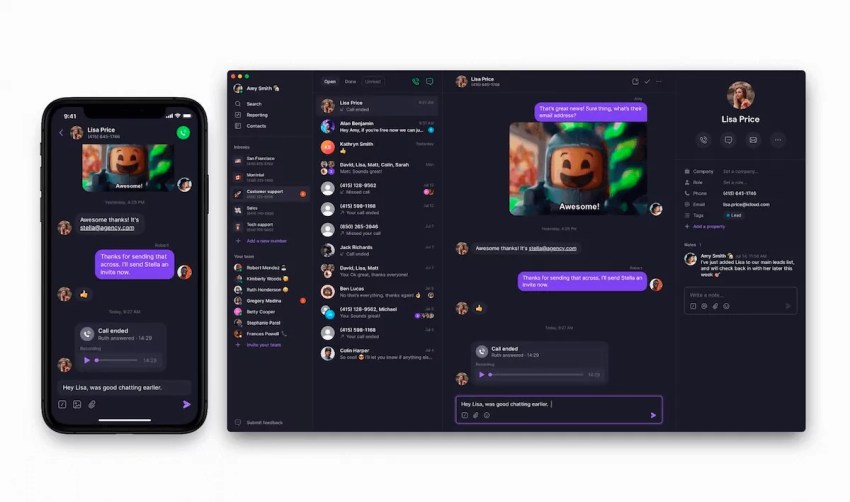
How it solves Zoom’s problems:
OpenPhone addresses Zoom’s biggest weakness: SMS.
- Shared SMS: Transforms your business phone number into a shared inbox, similar to a shared email address (e.g., support@).
- Team collaboration: Teams can view, assign, and comment on text conversations internally without the customer being aware.
- Simplicity: The user interface is clean, modern, and more intuitive.
Key features:
- Collaborative inboxes: Manage a single number with your entire team.
- Easy team communication: Cloud-based VoIP solution with collaboration tools.
- Internal threads: Add private comments on calls or texts.
- Snippets and auto-replies: Quickly answer common questions via text.
- Simple, modern UI: Clean, fast, and easy to use across web, desktop, and mobile.
Considerations: OpenPhone is not a complete UCaaS solution. It lacks call queues, advanced IVR systems, video conferencing, and the analytics capabilities of a contact center platform.
Pricing: Get OpenPhone’s pricing insights and breakdown below👇
5. JustCall
Best for: International sales teams and outbound calling.
JustCall is a purpose-built tool for sales teams. It’s less of a UCaaS platform and more of a sales-dialer-as-a-service that integrates directly with your CRM. Its strength is high-volume outbound calling.
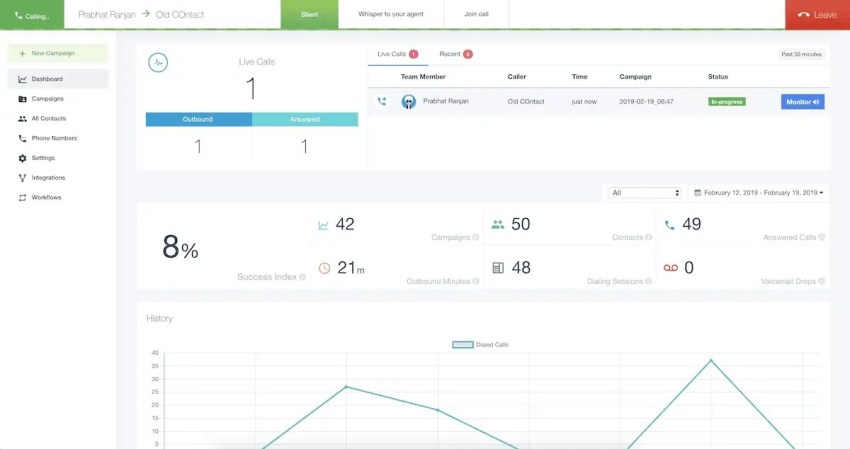
How it solves Zoom’s problems:
Zoom Phone is not built for sales teams. JustCall is.
- Sales-oriented tools: Offers calling features sales teams need, such as a power dialer, SMS workflows, and call history logging.
- Worldwide calling: Makes international calling easy and cost-effective, with local phone numbers in over 70 countries.
- CRM integration: Integrates with your CRM system (such as Pipedrive, Zoho, or HubSpot), and automatically logs all call and SMS activity.
Key features:
- Power dialer: Automatically dial through a list of contacts for outbound campaigns.
- International numbers: Easily purchase and manage local numbers in 70+ countries.
- SMS workflows: Automate text message sequences for follow-ups and campaigns.
- Strong CRM integrations: Native, two-way sync with the most popular CRMs.
Considerations: JustCall is not a unified communication platform. The focus is not on internal chat and video functions.
Pricing: Get JustCall’s pricing insights and breakdown below👇
6. 8×8
Best for: Mid-market companies that need an all-in-one value package.
8×8 is another long-standing competitor in the enterprise sector, combining voice, video, and chat solutions and known for its contact center plans that combine UCaaS (internal communications) and CCaaS (contact center).

How it solves Zoom’s problems:
8×8 includes:
- Integrated UCaaS/CCaaS: You get a complete plan that provides you with a full business phone system and a certified contact center — all from a single provider and in one app. With Zoom, you have to purchase Zoom Phone and Zoom Contact Center separately.
- Global reliability: 8×8 has a strong global presence and is known for its reliability and call quality.
Key features:
- Strong global presence: Local numbers and service in many countries.
- High reliability: Offers a 99.999% uptime SLA.
- Video conferencing: Includes its own robust video meeting solution.
Considerations: 8×8 can be more complex than a small business needs. While the user interface is functional, it’s less modern than that of some competitors.
Pricing: Get 8×8’s pricing insights and breakdown below 👇
7. Vonage
Best for: Businesses needing customization and APIs.
Vonage is an established VoIP provider known for its high reliability and, more recently, its powerful API platform. It’s a good choice for businesses that need to create customized communication workflows.

How it solves Zoom’s problems:
Vonage offers two solutions that trump Zoom: reliability and flexibility.
- Reliability: 99.999% availability and excellent call quality are appreciated by users.
- Customization: For technically proficient teams, Vonage’s APIs are a key advantage. They help develop customized communication solutions (e.g., automated SMS notifications, video support) not practically possible with Zoom’s closed system.
Key features:
- Vonage Business Communications (VBC): A reliable, feature-rich UCaaS platform.
- Powerful communication APIs: Build custom voice, video, and SMS applications.
- Strong CRM Integrations: Connects well with Salesforce, Zendesk, and more.
Considerations: The standard VBC application is functional, but less modern. Vonage’s strength lies in its APIs, which require development resources.
Pricing: Get Vonage’s pricing insights and breakdown below👇
8. Google Voice
Best for: Solopreneurs and small teams already in Google Workspace.
For solopreneurs or small teams already living in the Google ecosystem, Google Voice is the simplest and most common alternative. It provides a separate business number that works on your smartphone and computer.

How it solves Zoom’s problems:
Google Voice doesn’t solve Zoom’s advanced feature problems, but the cost and complexity problem by being radically simpler.
- Simplicity and familiarity: If you use Gmail and Google Calendar, you already know how to use Google Voice. It’s clean, simple, and has no learning curve.
- Low cost: It’s one of the most affordable, no-frills options on the market.
Key features:
- Google Workspace integration: Works perfectly with Google Calendar (for scheduling) and Google Meet (for video).
- Simple interface: Clean and familiar for any Google user.
- Device flexibility: Works on your web browser and a simple mobile app.
Considerations: Google Voice is extremely basic. It lacks advanced features like call queues, auto-attendants (IVR), shared numbers, robust analytics, or deep CRM integrations, and isn’t built to scale.
Which Zoom Phone Alternative Is Right for You?
Choosing the right provider comes down to the following business needs:
- If you need the best all-in-one platform for growth, Nextiva is the winner. It offers a scalable path from a powerful small business phone system to a full, AI-powered contact center, all on one platform.
- If you are a startup that is text-message-focused, OpenPhone is a good option. Its shared inbox for SMS is simple, collaborative, and solves Zoom’s messaging headache.
- If you run a sales team focused on AI-coaching, Dialpad is great for real-time AI. Its live transcription and coaching features work well for performance-driven teams.
- If you are an enterprise with existing desk phone hardware, RingCentral offers robust support for hybrid offices and legacy desk phone (Poly, Cisco) integrations.
- If you are a solopreneur already in the Google ecosystem, Google Voice is the simplest, most affordable (though limited) option to get a separate business number.
How We Selected the Best Zoom Phone Alternatives
For this list, we didn’t just look at features but evaluated each platform based on the real-world problems and limitations that growing businesses face when using Zoom Phone. Our criteria included:
- Core problem solving: How well does the alternative address Zoom’s main weaknesses, particularly regarding SMS, add-on pricing, and scalability?
- Ease of use: Is the platform intuitive for administrators and end users, or does it require a steep learning curve?
- Customer support and reliability: Does the provider offer a high uptime (e.g., 99.999%) and 24/7 support?
- Integration ecosystem: How tightly does the platform integrate with key business tools such as Salesforce, HubSpot, Microsoft Teams, and Google Workspace?
- Total value: Does the price reflect a complete solution, or is it a loss leader that requires expensive add-ons for essential functionality?
Why Growing Businesses Choose Nextiva
Zoom Phone is a great entry-level option, especially for teams already in its ecosystem. But businesses quickly hit a wall with missing features, clunky workarounds, and pricey add-ons.
This is where Nextiva stands apart. It counteracts most of Zoom Phone’s limitations.
- Feeling Zoom’s SMS limits? Nextiva’s Engage plan provides robust, team-oriented SMS and web chat.
- Need deeper CRM integration and analytics? The Power Suite CX plan integrates all your conversations — voice, email, and chat — into one thread and uses AI to transcribe and summarize them.
- Tired of add-on fatigue? Nextiva’s plans bundle key features like call recording and advanced AI-powered routing, offering a clear upgrade path without the ‘add-on’ feel.
While other alternatives on this list also effectively overcome Zoom’s limitations (such as OpenPhone for SMS or Dialpad for AI), Nextiva offers a complete, scalable, and unified solution for your entire business.
Upgrade to the best phone system in minutes
Begin calling in less than 10 minutes. Nextiva is #1 rated platform for business voice, text, and video.
FAQs About Zoom Phone Alternatives
Nextiva is one of the best Zoom Phone alternatives for small businesses and offers good call quality, built-in team messaging, video meetings, and advanced call routing. The VoIP system is easy to manage and scales as your business grows. Nextiva also provides excellent customer support, which is important for small teams that don’t have dedicated IT staff.
Other good options include Vonage and 8×8, depending on your size and communication needs. Dialpad is suitable for businesses that want AI features and a modern interface, while OpenPhone works well for small teams that need a shared number for collaboration.
Businesses often look for alternatives to Zoom Phone due to pricing, limited customer support, or a need for more integrated features. Some companies want deeper CRM connections, more flexible call management, or better uptime guarantees. Others prefer a platform that combines calling, messaging, and customer communication in one place. Choosing the right provider helps improve productivity and customer experience.
Switching from Zoom Phone is usually straightforward. Most VoIP providers offer number porting, which means you can keep your existing business numbers. Setup is typically handled online, and many providers assist with migration to avoid downtime. The process can take a few days depending on the number of lines and carriers involved, but it’s rarely disruptive if planned properly.
In most cases, you can use your existing desk phones with a Zoom Phone alternative. Most VoIP systems support standard SIP-compatible phones; they usually have a list of certified or supported phones, such as those from Poly, Yealink, or Cisco. Some providers may require firmware updates or specific configurations. If your current phones are older or locked to another service, you might need new devices or an adapter to connect them to the new system.
Vonage and 8×8 are excellent choices for international calling. Both offer competitive international rates, stable global coverage, and features like local numbers in multiple countries. 8×8, in particular, provides unlimited international calling to many destinations as part of its higher-tier plans. These options suit businesses with overseas clients or remote teams across different countries.
For basic communication needs, Google Voice and Skype are two of the best free alternatives to Zoom Phone. Google Voice suits individuals or small teams that need calling and voicemail. Skype supports free voice and video calls between users worldwide. However, both lack the advanced call routing, analytics, and professional support of full business phone systems. You can also consider Microsoft Teams (free version) and Google Meet (free), which provide essential communication tools but are not full-fledged phone systems.

















 VoIP
VoIP 















